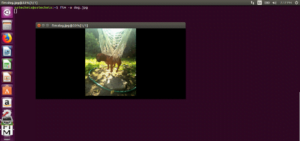

- #FRAMEBUFFER IMAGE VIEWER HOW TO#
- #FRAMEBUFFER IMAGE VIEWER PDF#
- #FRAMEBUFFER IMAGE VIEWER INSTALL#
- #FRAMEBUFFER IMAGE VIEWER SERIAL#
xterm, sixel, 16 grays, probably tenable on DEC VT340 xterm, sixel, mono, using a-dither The ASCII mode maps grayscale to a 1bit dithered 2x2 super resolution grid. It permits showing images inline with text or even doing interactiveĬode for keyboard interaction as the other terminal graphics backends.
#FRAMEBUFFER IMAGE VIEWER SERIAL#
Supported by some actual serial terminals, terminal emulators and printer. Sixels are a six pixels per character DEC printer/terminal graphics format Mlterm, sixel, 256 colors palette, dithering using a-dither'

Libpng and libjpeg - should work on most 32bit and 64bit x86 linuxĭistros - download and chmod a+x tv, then.
Now press y and then press#FRAMEBUFFER IMAGE VIEWER INSTALL#
Now run the following command to install FIM: sudo apt-get install fim. The apt package repository cache should be updated. X86 binary <900kb statically linked with musl, First update the apt package repository cache of your Ubuntu 18.04 LTS machine with the following command: sudo apt-get update. These sources to a public spot as well, ejoy :) Since my Patreon has been going well in its first week, I've pushed OVERVIEW fbv (FrameBuffer Viewer) is a simple program to view pictures on a linux framebuffer device. m specify no or invalid mode to get a list of valid modes Fork from GIF support through libungif has been removed as that library is obsolete. d set number of seconds of sleep between images in slideshow o write a thumbnail with -s' dimensions to thumb_path The popular framebuffer image viewer (feh and fbi) don't appear to support animated GIFs. The dimension is in pixels for sixel modes and in character
#FRAMEBUFFER IMAGE VIEWER PDF#
Space / backspace for moving through slides, +/- for zoom in and out, cursor keys to pan, S to toggle slideshow F to zoom to fit, W to zoom to width (and go top top - default for PDF pages.), j - jump to a specific frame number, shift-s to set slideshow delay, g to toggle grayscale, d to toggle dithering
#FRAMEBUFFER IMAGE VIEWER HOW TO#
For instructions on how to advance from one picture in the list to the next, see the KEYS section of man fbi. It takes a filename or series of filenames, and you can use shell globbing for this, so e.g.: fbi *.jpg

Fbi is available from the raspbian repos and should be in any other GNU/Linux distro as well it is not specific to the pi. The framebuffer is also what oxmplayer uses. You can use the command-line fbi app ("framebuffer image viewing").


 0 kommentar(er)
0 kommentar(er)
